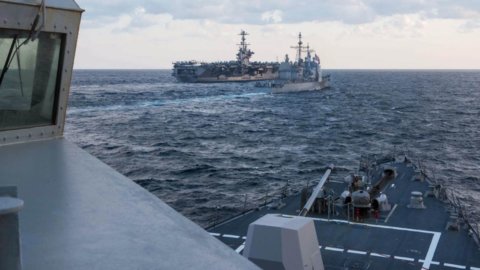Since the entry into force of the Treaty on the Non-Proliferation of Nuclear Weapons (NPT) in 1970, five countries officially possess atomic weapons: the United States, Russia (which inherited and manages the arsenal of the former Soviet Union), Great Britain , France and China. But there are three other countries that in the following years, while not part of the NPT, have joined the so-called "nuclear club", and they are India, Pakistan and North Korea.
The latter was actually part of the NPT until 2003, when it decided to leave and start its own nuclear weapons development program. Also the Federation of American Scientists, and essentially all institutions involved in monitoring the world's nuclear arsenals, assume the presence of atomic weapons in Israel is a given (although the Israeli government is ambiguous about it). In short, the total is nine.
Alongside the nine states, there are others that have worked in recent years to carve out a geopolitical role for themselves in the nuclear field. But some temporarily, others permanently, seem to have given up: this is the case of Iran, some states of the former Soviet empire (Belarus, Kazakhstan and Ukraine), South Africa, South Korea, Taiwan, Argentina and Brazil, of Iraq (which according to plan said goodbye with the Gulf War) and Libya (which voluntarily gave up in 2003, by decision of Gaddafi). A plan had been undertaken by Syria with the help of North Korea, but it did not go beyond the possession of enriched uranium and the construction of a reactor, destroyed by Israel in an air raid in 2007.
According to the latest Report of SIPRI (Stockholm International Peace Research Institute), more than 90% of the nuclear arsenal is held by Russia and the USA, even if the number of their nuclear warheads has progressively decreased. For what reason? The first is for unilateral choices; the second is the result of the New START, the Treaty on measures to further reduce and limit offensive strategic weapons of 2010. Washington and Moscow, according to an analysis published by Mauldin Economics last April, are also the only ones to officially possess the complete "triad" for the full use of the weapons possessed: land-based missiles, missiles from submarines and ordnance mounted on strategic bombers.
It is not certain, but it seems likely that China and India also have the "nuclear triad". In July 2017, again according to the FAS Bulletin of Atomic Scientists, the census of global nuclear warheads amounted to almost 15, of which 9400 were part of active military arsenals and even more than 5000 of these already deployed, mounted on missiles and ready for use. It should be emphasized that all these numbers are given by studies and analyzes by various international research bodies, but not all of them have official confirmations from the various countries. Almost always, in fact, the number of nuclear devices is a state secret.
An interesting fact concerns the trend in the number of nuclear warheads over time. In fact, since the Second World War, a real arms race has begun, which initially saw the United States acquire the most important nuclear arsenal. In the following years, however, the then Soviet Union caught up with and even surpassed the United States in terms of the number of nuclear weapons. Today Russia is the country that has the primacy in the world.
In the graph below we see the trend in the number of weapons in the various countries and (in red) the global trend, again according to data from the Bulletin of Atomic Scientists. Due to the scarcity of reliable data, North Korea has been left out. Scientists estimate that the Asian country has produced enough material for the construction of at least twenty nuclear warheads, but it is not known whether these weapons are actually ready for use or where the deposits are.
A first (small) decline in the production of global nuclear weapons can be seen around 1970, the year of the entry into force of the NPT Non-Proliferation Treaty. A second important reduction was recorded after 1986, the year in which, in October, the American president Ronald Reagan and the new secretary of the Soviet CPSU Mikhail Gorbachev met in Reykjavík to start a process of reduction of European and global nuclear arsenals. The agreement, called Intermediate-Range Nuclear Forces Treaty (INF), was reached the following year and signed in Washington in December 1987. The reduction underway in recent years does not, however, correspond to a diminished nuclear threat, because the weapons available today are much more powerful than those of the first decades. So the risk cannot be calculated only in the number of warheads, but if anything in the nuclear power available to each country.
Source: Eniday





